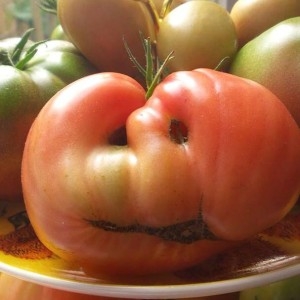We’ve talked about the supermarkets’ token efforts to offer ‘ugly’ produce at reduced prices. It’s a sop to environmentalists and low-income shoppers. But it’s made only negligible dent in the huge global food waste problem…

A three-pronged attack
The idea behind the Ugly Food movement is three-pronged. First, it’s aiming to reduce food waste at the farm gate by rescuing off-sized or deformed produce which would otherwise go to the landfill without ever seeing a store shelf. Second, it provides a way for low-income families to afford more fresh produce. And third, it’s a sure-fire winner in the ‘good corporate citizenship’ game.
Corporate image is no longer the top PR concern of modern mega-corporations, but it’s still of fundamental importance. And it does directly affect the bottom line. If folks don’t like you, they won’t buy your products.
What is ‘Ugly Food’?
It’s the crooked carrot. The creased tomato. The non-symmetrical apple. The lumby-bumpy potato. There’s no difference in nutritional value, flavour or texture between Uglies and the perfect, same-sized, blemish-free fruits and veggies you get at the supermarket. They’re just… Ugly.
As I said in the introduction, Loblaw’s and other major supermarket chains have made a big deal about selling ugly produce. But there are only a few types – mainly root veggies, overwhelmingly potatoes. It’s a half-hearted attempt, at best.
But there are now ‘Ugly’ options for shoppers from London, Ontario all the way through to Montreal. And it’s really hitting the price point that low-income shoppers need.
What is Eat Impact?
It’s a new grassroots grocery chain that specializes in Ugly food.
“The goal is helping people eat better, save money and fight food waste all at the same time,” founder Anna Stegink told The Canadian Press earlier this week.
Billions of pounds / kg of perfectly good, wholesome food are wasted each year, Stegink says. “It either rots in the fridge, the landfill or the farmer’s field.” We serious cooks are all too aware of that. And many of us are making a concerted attempt to reduce the wastage that occurs at home.
She’s not alone
There are other players in the Ugly Food marketplace. Spud is an online operation that serves a wide area in the Canadian West, “[including] the Lower Mainland and Vancouver Island in BC, as well as both Calgary and Edmonton in Alberta.” They bill themselves as a grocery delivery service, “that specializes in supporting local farmers, growers, producers, and artisans.”
The Odd Bunch, launched 18 months ago, offers seven different produce boxes at a frequency of up to once a week, sourced directly from farms and greenhouses in southwestern Ontario, the Niagara region and the Eastern Townships of Quebec.
And it’s just a matter of time before more vendors join the ranks of the Ugly Lovers. It’s a sleeper… But it could just turn out to be one of the biggest, most significant food sector trends of this year.
How they work
These vendors offer boxes of produce, delivered at regular intervals you choose. The contents of some boxes can be customized to suit your particular needs. Eat Impact, for example, offers small, medium and large boxes weekly for $19.95, $29.95 and $39.95 respectively.
Judging from the photos on the website, they contain a fair amount of food for the price, and a very good selection. But you’ll have to judge for yourself.
My take
I’d prefer a supermarket-style business model, under which I could pick and choose what I want, when I want. Spud offers this kind of shopping experience, but it’s very heavy on Organics. So most of its stuff costs about the same as regular produce in the supermarket. Although, it does represent a palpable saving over mainstream retail organic produce.
Bottom line: I’ll continue buying at the supermarket, shopping the sales and deals, and trying not to buy more than I need for the coming few days. But I’ll seriously consider switching to subscription-based box deliveries when I can get that pick-and-choose experience featuring conventional ugly produce, rather than premium-priced Organics.
But ours is a small household. Families of 4 or more should be able to cash in some significant savings using the services now operating.
~ Maggie J.

